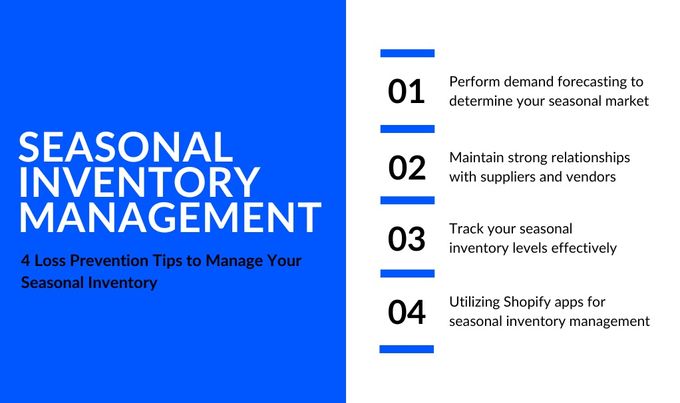Seasonal Inventory Management: 4 Loss Prevention Tips In E-commerce
Updated August 2, 2023

AI Summary
Seasonal inventory management presents special concerns for store owners. It's different from other inventory types because it creates strong peaks and valleys in demand based on timeframes and customer interest. This means you have a bigger chance of having too much or too little of specific seasonal products. Many store owners respond by ordering too much stock, only to see they don't sell enough. That's why loss prevention is a critical strategy—according to Bloomberg, $163 billion in inventory is tossed annually.
4 Loss Prevention Tips to Manage Your Seasonal Inventory
1. Perform Demand Forecasting to Determine Your Seasonal Market
Demand forecasting is the process of estimating your store's future sales.
When it comes to seasonal inventory management, demand forecasting accounts for changing consumer preferences to help you predict which products shoppers will buy. This, in turn, helps you avoid surplus inventory, anticipate future labor needs, and prepare your supply chain for expected seasonal peaks.
Popular Shopify inventory forecasting methods include:
- Evaluating historical sales data Did a specific product sell extremely well during a particular season? Has it consistently sold well over multiple years? This data can be instrumental in forecasting its prospective demand.
- Analyzing market trends What are the prevalent trends during a given season? How have your target audience's needs changed and habits changed? Use these insights to guide your inventory strategy for different seasons.
- Doing predictive analysis What's your current stock level? How much stock will you need in the future? Use a predictive analysis tool to gather these insights and optimize your inventory accordingly.
2. Maintain Strong Relationships With Suppliers and Vendors
Your suppliers can offer invaluable insights into their production schedules and lead times, which can greatly enhance your forecasting accuracy and prevent stockouts.
To maintain good relationships with suppliers and ensure timely delivery and availability of stock:
- Order early Ordering in advance, like holiday toys in the summer, not only ensures your seasonal readiness but also cultivates a strong relationship by showing respect for your supplier's time.
- Communicate often Regular chats with suppliers build trust. It demonstrates your commitment and keeps your store stocked for each season without any surprises.
- Negotiate terms When you have clear discussions about order size, delivery, and payment, it shows honesty. A strong relationship is built on such transparency, helping you adapt better to seasonal demands.
- Build contingency plans Creating backup plans with suppliers displays your confidence in them. It deepens the trust, strengthens the relationship, and guarantees a full inventory for any season.
3. Track Your Seasonal Inventory Levels Effectively
Seasonal inventory is very dynamic, which means inventory levels fluctuate all the time. Tracking your seasonal inventory in real-time helps you to make more accurate forecasts and replenish your stock in time.
Here are some inventory management systems to consider:
- Barcode scanning for efficient tracking Barcode scanning is a versatile, low-cost solution for keeping inventory counts accurate. It efficiently tracks product movements, enabling you to maintain a clear overview of your stock.
- Automation to streamline inventory management Automated inventory management optimizes your stock tracking process. The system continuously organizes and updates your inventory, ensuring smooth operations even during busy seasons.
- Cloud-based software for enhanced visibility Cloud-based software allows you to monitor your seasonal inventory whenever you need to. The convenience of checking stock levels anytime, anywhere helps you make informed decisions about your seasonal inventory.
4. Utilizing Shopify Apps for Seasonal Inventory Management
Certain Shopify apps can help you manage and optimize seasonal inventory. These apps contain features like automatic sorting, low stock notifications, and more to facilitate better inventory management. Here are two apps you can use to streamline inventory processes and capture more sales:
1. Bestsellers reSort
Bestsellers reSort is a product management app that lets you sort your Shopify products within collections using custom rules.
Have overstocks of certain products you need to push?
Sold out of other products unexpectedly?
Want to highlight your bestsellers?
Bestsellers reSort gives you complete control over your product organization and lets you automatically display your desired products at the top of collections. Plus, you can give each collection its own sorting rules, whether it's via sales, views, date, or your own custom tags.
» Read our full Bestsellers reSort review for more information
2. Out-of-Stock Police
Out-of-Stock Police is an inventory management app that helps you keep track of your out-of-stock products. The app automatically pushes your sold-out products to the bottom of your collection and hides them completely if they don't come back in stock within a certain time period. This way, customers can focus on available items while you keep your seasonal stock organized and visible.
» Explore our full Out-of-Stock Police review for more details
Leveraging Marketing and Promotions for Seasonal Sales
Effectively managing seasonal inventory is a multifaceted task. By implementing loss prevention tips like the ones discussed here, you can potentially minimize financial losses. Plus, integrating marketing strategies and promotions to boost seasonal sales while maintaining efficient inventory management can further enhance your efforts in reducing losses. By combining these strategies, you create a potent approach that can significantly mitigate losses in seasonal inventory management.








